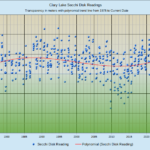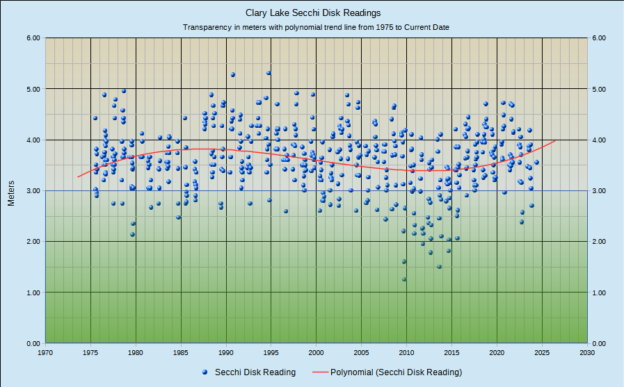 Kelsie French and I resumed our water quality monitoring efforts for 2024 on Sunday May 5th, a little earlier than in recent years. The lake is still largely homogenous with a surface temperature of 13.3°C (55.9°F) and 11.2°C at 8 meters. Surface DO was 11.3 mg/L and 8.4 mg/L at 8 meters. The Secchi disk reading was 3.55 meters (11.6 feet) which I guess is about normal for this time of year, but nothing to write home about. You can see where it lands on the chart at left (the sole data point, far to the right, in the 2024 column right below the red trendline). You can see a subset of water quality data including transparency going back to 2001 on our Clary Lake Water Quality Monitoring Data page. Today the water was kind of murky. Despite being early in the season, there’s already phytoplankton, primarily diatoms, populating the lake. As the water warms up, the diatoms will mostly die off to be replaced by green and blue-green algae later in the season. It’s really the blue-green algae (Cyanobacteria) that we’re worried about. Blue-green algae is mostly a late summer and fall phenomena.
Kelsie French and I resumed our water quality monitoring efforts for 2024 on Sunday May 5th, a little earlier than in recent years. The lake is still largely homogenous with a surface temperature of 13.3°C (55.9°F) and 11.2°C at 8 meters. Surface DO was 11.3 mg/L and 8.4 mg/L at 8 meters. The Secchi disk reading was 3.55 meters (11.6 feet) which I guess is about normal for this time of year, but nothing to write home about. You can see where it lands on the chart at left (the sole data point, far to the right, in the 2024 column right below the red trendline). You can see a subset of water quality data including transparency going back to 2001 on our Clary Lake Water Quality Monitoring Data page. Today the water was kind of murky. Despite being early in the season, there’s already phytoplankton, primarily diatoms, populating the lake. As the water warms up, the diatoms will mostly die off to be replaced by green and blue-green algae later in the season. It’s really the blue-green algae (Cyanobacteria) that we’re worried about. Blue-green algae is mostly a late summer and fall phenomena.
As the lake warms up it will begin to stratify with warmer, oxygen-rich water near the surface and colder, oxygen-deficient water near the bottom. By mid-summer, there’ll be a clearly defined thermocline with warm water above it and cold water below, with essentially no oxygen in the bottom 3rd of the lake. The lack of oxygen is due to the decomposition of organic matter in the water by microbes and bacteria, a process which consume oxygen. We’ll be going out every 2 weeks to collect data until sometime in October. Today the water was actually warmer than the air. We’re looking forward to warmer weather than what we worked in today!



